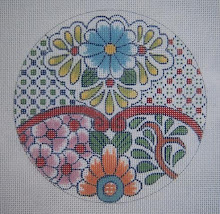 First, I want to share the Holiday card I received from the staff of Needlepoint Now - I'm sure all subscribers have one by now.
First, I want to share the Holiday card I received from the staff of Needlepoint Now - I'm sure all subscribers have one by now.I was ROFL at the message, as I know there are very few who don't know exactly what the sentiment is saying - without having to consult color cards. Clever girl, our Elizabeth, (new owner and editor-in-chief of the magazine), whose name is signed in what looks more like 002HL than 202HL.
 So now to the business at hand. I haven't been diligent about posting lately, as I was busy with other things, and working on three canvases simultaneously. The Sunflower Cross in Talavera is the first of these on which I have been able to use beads.
So now to the business at hand. I haven't been diligent about posting lately, as I was busy with other things, and working on three canvases simultaneously. The Sunflower Cross in Talavera is the first of these on which I have been able to use beads. These designs are so suitable for my enjoyment of using simple stitches (almost entirely basketweave) with simple materials - mainly DMC floss and Kreinik metallics. However, I felt that the sunflower center definitely needed something extra, so I placed ink dots on the weft threads in a lattice pattern based on a count of 3. Then, DMC floss in brown is worked around the dots in basketweave, and then beads placed. (Sundance, of course, in brown - not sparkling, but simply shiny.)
The next photo shows how the cross looks now, with some color added. I have been watching a most delightful BBC mini-series on DVD's, (The Duchess of Duke Street) and decided to just do outlining, which doesn't require much concentration - just relaxing.
You can see how the simple color markings with the Sharpie permanent pen are guides to shading the flat flower petals. There was no need to paint them, but I did need guidelines.
The burgundy colored diagonal band is worked with DMC cotton floss and Kreinik metallic blending filament in a Vintage color almost the same.
I really like this Vintage, as it doesn't sparkle, but emits a subtle gleam in the orange and the burgundy on this piece.
The last two pictures are of one of the "mini-crosses," first with just some color added, and the last one with background - this shows so well how the pattern really pops out against the matte floss in navy 018.
Now - back to an evening with the Duchess and more stitching. Tomorrow I paint!! At this time, I am planning great entertainment with old Tyrone Power swashbuckling movies from the 50's - which I loved when I was an impressionable child.
If I had had the chuzpah of the Duchess of Duke Street, my children wouldn't be running my life now.

 Anne Stradal has begun a new design series of clocks - I really look forward to this one, as she will include the well researched history of each, just as she does with her charming lighthouses.
Anne Stradal has begun a new design series of clocks - I really look forward to this one, as she will include the well researched history of each, just as she does with her charming lighthouses. 

























